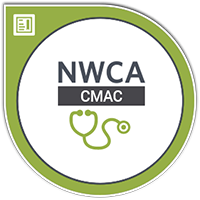Clinical Medical Assistant
Online Certification Course from Hampton Roads Community Action Programs, Inc.
Program Description
The Clinical Medical Assisting online certification course from Hampton Roads Community Action Programs, Inc. is designed to prepare students to function as professionals in multiple healthcare settings. Medical assistants with a clinical background perform various clinical tasks including assisting with the administration of medications and with minor procedures, performing an EKG electrocardiogram, obtaining laboratory specimens for testing, educating patients, and other related tasks. Job opportunities are prevalent with physician’s offices, clinics, chiropractor’s offices, hospitals and outpatient facilities.
This online program prepares learners to assist physicians by performing functions related to the clinical aspects of a medical office. Instruction includes preparing patients for examination and treatment, routine laboratory procedures, pharmacology, taking and documenting vital signs, technical aspects of phlebotomy, the 12-lead EKG and the cardiac life cycle. The purpose of the Clinical Medical Assisting certification course is to prepare learners to assist physicians by performing functions related to the clinical aspects of a medical office.
Program Objectives
After completing this program, learners will be able to:
- Explain the clinical medical assistant's role in patient-centered care within the medical facility
- Describe the specific personal characteristics, interpersonal communications, and professional skills required of the clinical medical assistant
- Demonstrate an understanding of medical facility safety practices, measures, plans, and standards
- Explain the steps in quality care throughout the patient encounter including preparation of the medical facility, completing required paperwork, taking vital signs, and completing the check-out tasks
- Explain the concepts related to medical asepsis and surgical asepsis in the healthcare environment
- Demonstrate knowledge and skills related to pharmacology and the administration of medications within the scope of the clinical medical assistant practice
- Explain the concepts related to medical asepsis and surgical asepsis in the healthcare environment
- Explain the medical assistant's role and tasks when helping with minor surgery and diagnostic testing procedures in the medical office, including laboratory procedures, specimen collection, microscopic assessment, and hematology procedures
- Demonstrate the ability to assist the physician as directed in various medical specialties of the medical office
- Explain considerations of healthcare for special populations including pediatrics and geriatrics
- Apply the basic electrophysiologic principles of cardiac conduction to the anatomy and physiology of the body
- Identify proper placement of leads to ensure an accurate and consistent EKG reading
- Evaluate various EKG rhythm strips following established normal criteria for each of the wave forms and intervals
- Analyze a variety of EKG rhythm strips, identifying rate, rhythm and intervals
- Analyze a variety of EKG rhythm strips for common dysrhythmias
- Apply an understanding of the technical aspects of the EKG machine to the correct use of the machine and interpretation of artifacts
- Describe the functions, associated terminology, types, and rhythm strips of pacemakers
- Describe diagnostic electrocardiography in terms of goals, types, procedures, indications, and contraindications
- Explain how to interpret a 12-lead EKG strip
- Explain myocardial infarction in terms of physiology, symptoms, and EKG interpretation
- Describe common cardiac medications
- Explain the steps in selected specimen collection procedures performed by the phlebotomy technician
- Explain the safety procedures in the healthcare setting and specifically in performing specimen collection procedures
- Identify specific supplies and equipment used in selected specimen collection procedures
- Explain precautions and guidelines when collecting specimens in special populations such as pediatrics and geriatrics
- Define quality of care and explain the impact on patient medical care when quality and safety are compromised in phlebotomy procedures
- Describe the anatomy, physiology, pathophysiology, and medical terminology associated with phlebotomy
- Describe the requirements of the successful phlebotomy career including desired character traits, training and education, roles and responsibilities
- Explain how phlebotomists communicate with others in the healthcare setting verbally, nonverbally, within the health record, and using computer systems
- Identify common legal issues, ethical issues, and regulatory issues commonly impacting the phlebotomist
Certification Opportunities
After completing this program, learners will have the option to take the leading national/industry-recognized certification exams essential to entry-level employment in this fast-growing field.
 |
National Workforce Career Association (NWCA) Clinical Medical Assistant Certification (CMAC) |
| National Healthcareer Association (NHA) Certified Clinical Medical Assistant (CCMA) |
Optional Volunteer Externship Opportunity
Learners who complete this program are eligible to participate in an optional volunteer externship opportunity with a local company/agency/organization whose work aligns with this area of study in order to gain valuable hands-on experience. As learners progress through their eLearning program, an Externship Coordinator will reach out to coordinate placement.
Note: Additional documentation including health records, immunizations, drug-screening, criminal background checks, etc. may be required by the externship facility.

Requirements
- High School Diploma or GED
Program Details
- Mobile-Ready
- Video Lesson Presentations
- All Textbooks
- 24/7 Learner Support
- Certificate of Completion
- Clinical Externship Opportunity